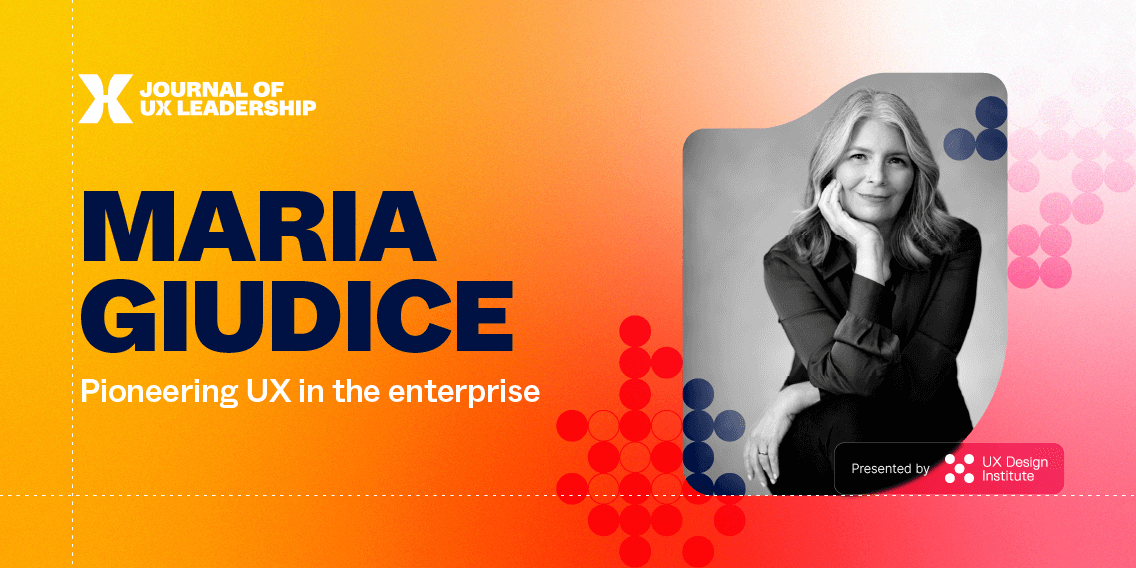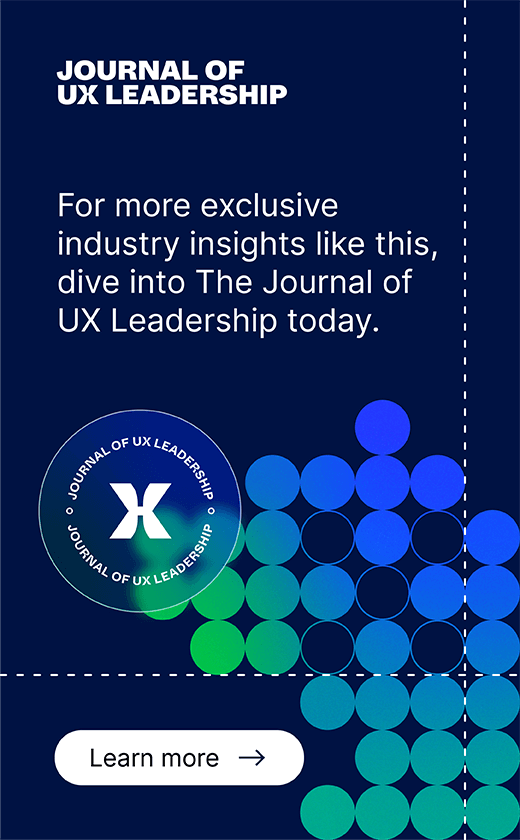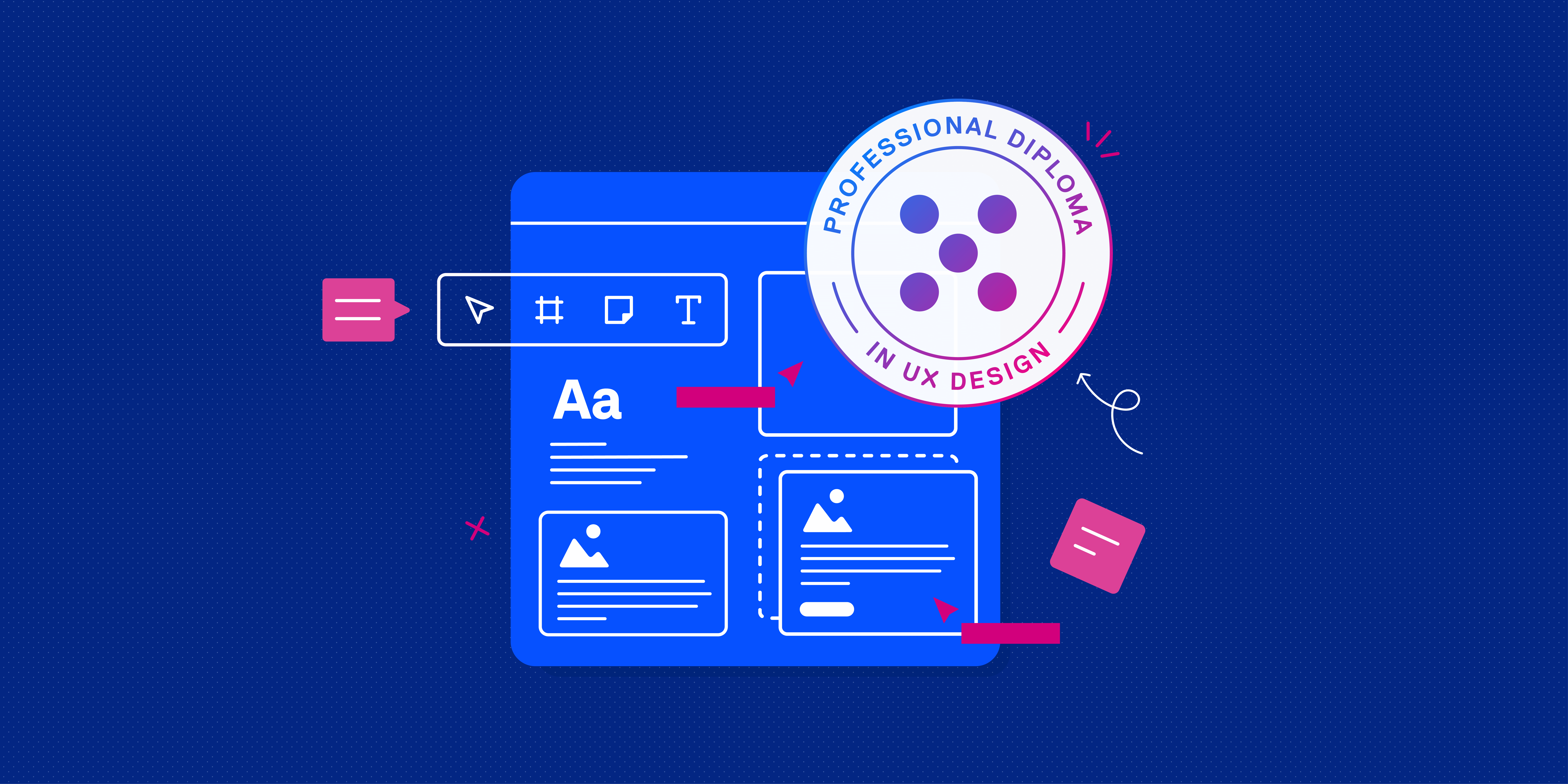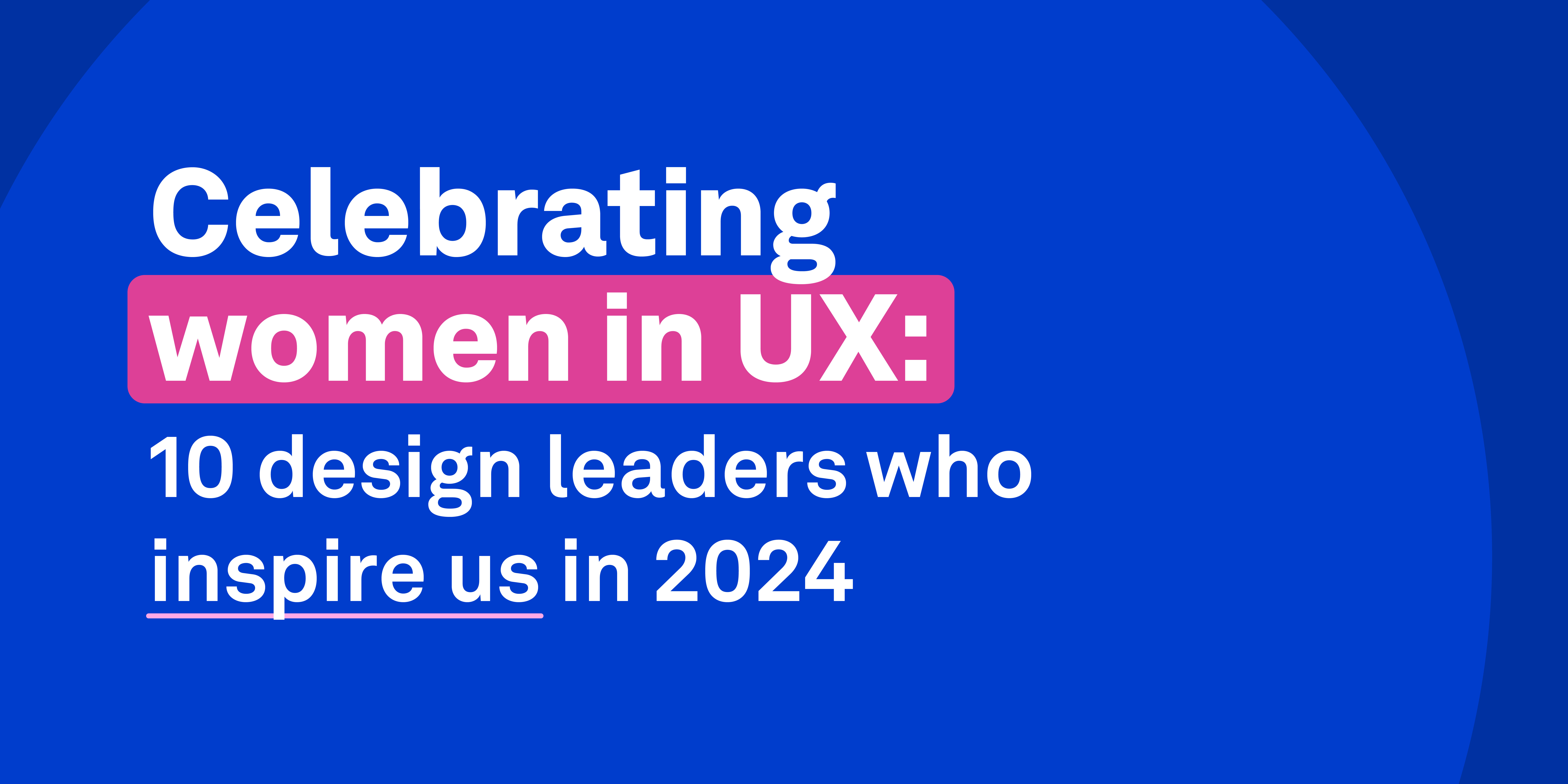Maria Giudice is on a mission to forge the next generation of creative leaders. After a 30-year career starting, growing and selling agencies before leading design practices for Facebook and Autodesk, she’s paying it forward. While she would never use that phrase herself, her career brought her in contact with two designers who lit a flame within her which has never extinguished – Richard Worman and Clement Mok – and now it’s her turn to do it for today’s emerging designers.
Note: This interview was conducted for the Journal of UX Leadership, a new publication from the UX Design Institute for ambitious UX professionals who want to learn from their peers and grow their careers.
Career highlights at a glance:
- Partner, YO, 1992 to 1997
- Founder, Hot Studio, 1997 to 2013
- Director of Product Design, Facebook, 2013 to 2015
- VP, Experience Design, Autodesk, 2015 to 2018
- Adjunct Professor, California College of the Arts, 1999 to present
- Certified Executive Leadership Coach, 2018 to present
- Co-author, Rise of the DEO and Changemakers
Interview themes at a glance:
- Design and business can get along
- Navigating the Wild West of the web’s early days
- Collaboration as the energising force
- The growth of Hot Studio
- UX in corporate America
- Skills and lessons
Gareth Dunlop: Over your career you’ve been involved in startups, in academia, and in the world of entrepreneurism. You’ve done small, you’ve done corporate, you’re currently mentoring. You’ve started, grown, sold and pivoted. There’s a lot of energy emanating from your website and your LinkedIn profile. How did you end up having the career you’ve had?
Maria Giudice: It’s been a long career but incredibly fulfilling. I started out as a painter in New York – I have an uncle who is a famous fantasy art painter called Frank Frazetta. I was really influenced by him just admiring that he could have a career as a painter and from as young as eight or nine years old I would spend my Saturdays at a painting class.
I realized early that I was a very smart business woman because my mother used to teach cooking in the basement of our house, and I had paintings on the wall, and her students one day said, hey, can your daughter paint portraits of dogs? So I started painting dog portraits when I was 15 years old and making money from my art. I saw early on that you could combine something that you love to do and make money at it. I never had that fear as a child that going into a creative career would mean that I would be living out in the street in a tent.
It’s a super important foundation because then I went to art school, [where] I learned graphic design. And in art school I met my first boss, Richard Saul Worman, who really coined the phrase information architecture. And I worked for him right out of school.
GD: I’m interested in how your career became entrepreneurial. Was it simply a case of putting into practice what you’d learned as a teenager, and you started to put your money where your talents were and make a living from it?
MG: When I was a teenager, I would paint jean jackets of album covers. This is where I’m really dating myself. I would charge a hundred dollars a jean jacket, which was outrageous at the time, and I would do it while babysitting, essentially doubling my hourly rate.
GD: Was it natural for you to evolve from making some teenage money to setting up a business as an adult? You set up YO and subsequently Hot Studio very early in your career.
MG: When I was in college, I took graphic design classes just to diversify my knowledge about art and design. But I had no interest in being a graphic designer, zero, because I just thought it was a formulaic exercise – here are your fonts, here’s the white space, slap an image, make sure your type is flush left and call it a day. Right?
It wasn’t until my senior year of college when Richard Worman was a guest speaker in my class that it clicked for me. I didn’t know who he was and most people in my class didn’t know who he was. He looked nothing like a typical designer in the eighties. We’re talking about 1984, 1985, when designers were predominantly white males who were beautifully dressed in black, who were mean to their employees, who were misogynistic and had no interest in collaboration.
Design is not about you. It’s about helping people make sense of the world.
I was this rough and tumble girl with teased up hair who cursed up a storm and had a funny accent. I really didn’t feel like I belonged in design, but that all changed when I met Richard. When he walked into our room – he’s an architect, short, chubby. He had a big scarf on. He cursed up a storm. He looked at us all in the class and said, I’m paraphrasing, but this is how I remember it. “You’re all full of shit. Design is not about you. It’s about helping people make sense of the world.” And it was like, fucking mic drop. It was a lightning bolt moment.
Finally, it all connected for me. That design was super important to help people understand, and I just jumped and worked for him right out of college. He understood design from a systematic point of view, he’s looking at design in themes, he’s looking at design in terms of time and space, he’s looking at design as a form of navigation. His designs were meant to be useful and helpful and help people understand. I would say he was a renegade at the time because those designers at the time kind of thought his work was ugly, right? Their work was more about beautification, whereas his was more about understandability.
That became imbued in me. I looked at design from that lens of people-centric. Who are we designing for? What do they need to know? How do they need to feel? What’s their goal? These are all basic ways that we look at design today, but nobody was looking at design from that point of view back then. We were just a bunch of information architecture outcasts. It was so unusual that in the mid 90s Richard wrote a book called Information Architects, which defined what information architecture was. It’s a common term today but it was he who coined it. In the end it just became something that we did by default.
The early days of the web
GD: Much of that resonates because my father is a retired architect. As my career in UX has progressed, I have consistently been struck by the overlap between good architecture and the best of digital and product design. There’s something about architecture where a sense of place is baked into how they do their work, where context and light and shape and surroundings are just wrapped into how they think. I suppose digital design probably took a bit longer to think that way than possibly it should have?
MG: I do think architects make incredible designers. My son is studying architecture, so I’m very, very proud of that. But in those early days I would say the first UX people were writers and editors.
In those early days when the web was emerging, nobody really knew, nobody had a process. We were really figuring our way through it. The web created a need for multidisciplinary people to work together and a lot of my early colleagues in information design came from the editorial community because journalists do a very similar thing. They are inquiring, they have a hypothesis, they have a question. They have to assemble their thoughts and themes. They have to tell a story.
Everybody was welcome because there were no rules. Those were the early days of Macromedia and CD ROMs, with their need for storytelling, architecture and development. Nobody really had titles at that point there. Nobody called themself a UX person. I love that within the experience design field people come into the profession later on in their career. So they don’t have to follow the singular path of having to go to art school, get a certificate in UX, do the X, Y and Z. You can come into this from other points of view, which are going to be additive in terms of your life experience and what you bring to the table.
GD: The influence that other design disciplines have on UX is a constant thread through many of my conversations with UX leaders. I’m always curious to look back into the history of the influences which have come together to be this thing that we call UX. How far back might we go?
MG: We are always borrowing from generations before us and maybe lifetimes before us if you believe that sort of thing. We rediscover things in our lives, but what’s constant is that we are human beings. We’ve evolved, we’ve got emotions, we’ve got thoughts, we’re kind of messy. My school Cooper Union was heavily influenced by the Basel School of Design and by Bauhaus. I think we can go back to even the Russian Revolution, and before the Bauhaus, there was Cubism.
The growth of Hot Studio
GD: I’d love to know more from the early days of Hot through to the present day, in particular your experience forming, growing and selling an agency and then having more corporate leadership roles.
MG: I feel like I accidentally founded a company but I realized early on that I loved collaborating with people. So starting and building a company felt very natural to me because I love the idea of finding incredible people to work together to solve problems. I really believe in multidisciplinary collaboration and co-creation with clients. All of that was the basis of Hot Studio and the reason why some of the top people were attracted to the business. They would come into a culture of openness and welcoming with the goal of knocking back the egos and working together in service to the people that we’re designing for.
I had experience designing websites because my first website was done around 1993. So there were some things that I had a specialty in which became the DNA to build my company around. I trained a lot of people to think like information designers back then.
I then focused on bringing in people who were more visual, better visual designers than me, and soon after that I started bringing in different disciplines as the company grew. I never said I wanted to have a huge company, but by the time I sold Hot the company was about 80 people, 100 with freelancers. It just grew over time because the work got more complicated and more interesting. When I sold the business in 2013, it was a large company and we had survived three or four downturns. It was very rewarding, but really hard. I had two kids at the time, and I was approaching 50 years old and I was reflecting on what I wanted the rest of my career to look like.
I remember telling somebody, “I don’t want to be put in a box”. And one of my bosses said “Maria, you are in corporate America. You will be put in a box!
I was hitting a wall where I wasn’t growing anymore. I was just building a bigger company and it was feeling increasingly like a hamster wheel. So I told the universe that at some point I want to sell my company. I was always very open with my employees – I let them know that I’m either going to sell the company or I’m not, but I’m not going to be 80 years old running Hot.
Facebook was my client at the time, and they only had 50 designers when we started working with them. They saw an opportunity to essentially double their pool of designers by acquiring our company. The timing was right for me, it was right for the company and it was right for Facebook. So we sold, we closed down Hot, and many of us went to work at Facebook. Even though I had a lot of experience working with corporate clients externally, I had underestimated how hard it is to work inside the corporation.
UX in corporate America
GD: You came from an independent ambitious agency where I’m sure you weren’t a dictator, but you would have had influence over a lot of the decisions. All of a sudden, you’re part of a big corporate machine, and I’m guessing that’s going to be very different?
MG: I underestimated how hard it would be on myself and others. Some people had corporate experience and really thrived, others didn’t. I struggled at Facebook because I remember telling somebody, “I don’t want to be put in a box”. And one of my bosses said “Maria, you are in corporate America. You will be put in a box!” I felt like I couldn’t be strategic – it was all about execution, which wasn’t really right for me.
I was twice the age as most of the people at Facebook, so I was a different generation, and I just really struggled. But I learned so much from that experience. I learned how to ship at scale. I learned the impact that design could have on people outside the US. I worked with the smartest people I’ve ever met in my entire life.
I got recruited to go work at Autodesk to be the VP of Design, which was a much better fit because I got to work across the whole company. I was respected by the CEO and the Chief Product Officer, whom I reported to. My role focused on helping the company, traditionally an engineering centric company, step into what it meant to be people-centered in terms of design. There were 400 designers in the company worldwide and I was called to be a changemaker. I loved it there.
After two years of bliss the CEO decided to step down, and my boss decided to leave. There was a shift in leadership in the company, and they really were not on board with what I was doing – they did not think that design was the center of the universe as I thought it was! [laughs] I got pushed out, and that was a very brutal experience because I’ve had this stellar career with gold stars my whole life, and suddenly I’m shown the door after feeling I’ve achieved so much at Autodesk. And then that’s when I went through my midlife crisis.
GD: I’m sure there’s part of you asking yourself, do they know who I am [laughs]? You guys are making a mistake. You mustn’t fully understand?!
MG: It was brutal. But it was also a learning experience because now I know what it feels like for all the people who are losing their job. I started going on interviews for more VP jobs because I’m a VP, but another person came into my life called Clement Mok, who was Apple’s Creative Director when Steve Jobs was there. I was telling him how I was feeling – I was going on all these interviews and I was feeling like I was faking it. And he just said, “Why?” He was right – I didn’t need the money and I had already proven myself in the industry – but yet my critical voice was saying, you have to keep going. He advised me to stop, which is just what I did.
I just started getting curious and doing things that I never got to do because I always had a job and children and never enough time. I wrote Rise of the DEO in 2013, which was a book about how people who think like designers make great CEOs. It’s based on a simple idea that design leaders are DEOs, right? Design Executive Officers. If we look at it 10 years later, there’s so many designers in these high positions of power. There are DEOs all over the place now. Fundamentally, our role as designers is changing. We’re no longer leading design. We’re leading change at scale.
I was just applying good design thinking to solving problems about how to create systemic change at scale. I embarked on interviewing design leaders for three years about their roles and their failures and successes and tips and tricks. And that became the book that just came out last week called Changemakers, which I co-authored with Christopher Island, who co-authored Rise of the DEO with me.
Fundamentally, our role as designers is changing. We’re no longer leading design. We’re leading change at scale.
GD: Looking at that midsection of your career from Hot to Facebook to Autodesk, how would you assess their UX maturity? What was an independent agency like Hot able to do well which corporates couldn’t, and vice versa?
MG: I think that there’s still a bias in product companies against people who work in agencies.
When Hot was brought into Facebook there were certain designers at Facebook who I think didn’t really understand or respect the skills that agency people can bring in. Because the thing about agencies is, boy, you learn how to work fast. You learn how to work on budget, you learn how to execute, you learn how to work with clients. Whereas in product you learn how to go deep, you learn how to look at data, you learn how to work more closely with engineers and product managers. I believe that designers should work in both contexts
Within the agency world you don’t really have the access to the quality of data that you do in product because the data is always outside of your purview. The other downfall of working in an agency is you are hired for a period of time, and then you don’t really know if your work is ever going to come to fruition. So there is that risk that you’ve done all of this work and then you leave it with somebody and it can just blow up.
GD: One of the most challenging biases to overcome when it comes to making good design decisions is that larger organizations tend to be more hierarchical. What that can mean is that the people who are higher up the hierarchy inadvertently get their own way more than possibly they should based on the data or the research. Was that an issue in your experience?
MG: Hierarchy is a big thing, and is something that I experienced in both corporate settings. As a change maker, you have to work with hierarchy as an ingredient, as one of the factors. First of all, there are silos like crazy. In big corporate America, one of the biggest challenges is breaking out of the silos. I saw this really clearly at Autodesk, if you’re trying to go from a customer who’s interested in a product to purchasing a product, there were like 37 touchpoints to get from interest to purchasing a product, cutting across 5 different silos.
You could see the seams of the silos in this very fractured customer experience. So a part of my job was to expose those seams, to say, “OK silo I’m going to show you what it’s like to buy a product on Autodesk, and here’s some customer stories that show you that you are doing a disservice to your customers because they are struggling at every point going from one silo to another.”
You have to work with silos, and you have to work with hierarchy, and you have to build a better understanding of what threatens people in hierarchical organizations, right? Because people who are in hierarchical organizations really fight hard to be in the career ladder that they’re in. It’s almost like a battleground for them. “I made it to senior manager, I’m not going to let this person screw with me getting to VP, right? I don’t care if it’s better for the customer, I care about getting to the VP level, so I’m going to protect my battleground.”
[As design leaders] if we can be compassionate and empathetic towards them and realize they’re afraid we’re going to derail their goals, whether they’re personal or professional or company goals. So how do you align better with these potential detractors in an organization? How do we help them be successful?
The word UX gets in the way because people think of UX as wire framing.
In a lot of ways I think designers are faithful to the customer. There’s so much work to be done by being faithful to our peers, the people that we report to, and the people that report to us. If we can show the same amount of empathy and compassion to people inside companies, then we do with the customers outside companies, we’re going to be better at what we do. It’s not going to eliminate silos or threats, but we can smooth out those edges and we might be able to get further along than just being blocked from an action that needs to happen inside a company.
Lessons learned
GD: So empathy and investing in peers is a really helpful complementary activity to investing in the customer? What other ingredients do you think makes a great design leader?
MG: We have been clawing our way for decades to get respect in companies. We always felt like the ugly stepchild that always had to defend why our work is so critically important. Because of that, we have really gotten louder, which is great. However because of that trauma that we’ve experienced in our industry, we put design as the center of the universe.
We talk about design, we evangelize design and we are constantly using data and customers as evidence for our relevance. But we need to realize that many people and companies don’t really understand what design is. As much as we try to explain it to them, they get hung up on it thinking it might mean decoration, it might mean something that’s not important enough. They’re going to bring their own bias into that idea and so as designers, we have to just drop the word design altogether.
My advice is be aware of the taxonomy in the culture and the environment that you’re in, because design is going to happen, but sometimes the word itself gets in the way. And UX itself, the word UX gets in the way because people think of UX as wire framing.
I think of Jake Knapp’s book Sprint. It’s so funny because the Google Sprint process is just a really accelerated design process, which is what we did when we worked with startups at Hot. These were early days of Agile – we didn’t call it a phase zero, but it was typically an exploratory week of intense design planning. When we did that phase zero sprint we had to sell it really hard. Then Jake Knapp comes along and calls it like the Google Sprint process. He uses engineering language, and it becomes accepted among the engineering community. So that’s an example of the same process, but repackaged using language that is going to be more meaningful to the people that you’re working with, you’re going to get the job done.
GD: I’m interested to know your thoughts on what our big skills challenges are as an industry?
MG: I think working with data is a big opportunity area for UX and designers in general – we need to really partner better with data scientists and system architects. We’re also going to have to really reckon with AI and ethics around what we do.
We constantly have to ask ourselves about bad actors, we have to stop thinking about the best case scenario. We have to start designing the worst case scenario and planning back from there. We have to think about long-term impacts that we have might exist on our design decisions. So really now we have a page of learning about what’s our responsibility as designers to do the right thing.
GD: Finally, If you and I meet again in 2033 what UX challenges might we be thinking about? Things just creeping onto our horizon now, which in five or 10 years time will have the focus and energy of UX professionals?
MG: I am so grateful to be in this industry, in this field, because we are so grounded in skills that are going to be applicable no matter what is thrown at us in the future. The fact that we are compassionate, empathetic people who care about making an impact on people’s lives, being in service to others, being able to look at systems, using intuition and analytics and risk taking, and being change agents.
All of these skills that we have are evergreen and can be reapplied in any context that is coming at us in the future. And that’s a beautiful thing.






